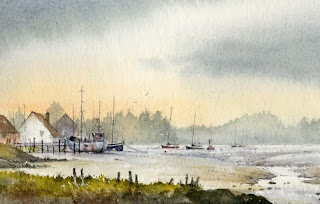Recently I received an interesting email asking how to develop an artist’s ‘mindsight,’ or visualisation in constructing a painting. This is more than just assembling the various parts of a composition, and brings in more about your own feelings and imagination into the equation.
 This watercolour of the Pembrokeshire coast at Amroth is an example of how visualization created a really different painting from what I saw in reality. I sketched the scene in mid-afternoon with light coming from the left. I could see the village and background hills and cliffs in strong detail and an overwhelming green. There was little atmosphere. In the studio I played around with studio sketches, tried various lighting and mood effects and considered how to increase the dramatic effect. I needed to lose most of the detail and the greenery.
This watercolour of the Pembrokeshire coast at Amroth is an example of how visualization created a really different painting from what I saw in reality. I sketched the scene in mid-afternoon with light coming from the left. I could see the village and background hills and cliffs in strong detail and an overwhelming green. There was little atmosphere. In the studio I played around with studio sketches, tried various lighting and mood effects and considered how to increase the dramatic effect. I needed to lose most of the detail and the greenery.
I decided to change the lighting to an evening sky, bringing in atmospheric cloud to lose much of the hills, and enhance the unity by using few colours in the background, mainly French ultramarine and cadmium red. Backlighting like this adds dramatic appeal and the cascade of light above the houses highlights them as a focal point. The dark closer rocks and cliff create a sense of space, again painted in with the same colours as the background only with much stronger tones and the addition of yellow ochre in places.
How do you develop this visualisation of a scene? Firstly seek out dramatic lighting situations, sketching, recording and photographing strong atmosphere, moving around to find the most dramatic viewpoint and observing the effects created in these situations. Secondly study these phenomena at exhibitions, in books, etc, in the work of good landscape artists. Experiment with ideas, exaggerating height, tonal values and atmospheric effects, and using your imagination to create mystery, drama, intense light or moody shadows. Eliminate features that don’t work for you. This all takes time and experience, but if you make a deliberate effort to work on this aspect of painting it will improve your work enormously.
My Skies, Light & Atmosphere in Watercolour book contains a great many paintings that have been enhanced dramatically by visualising the overall atmosphere before touching the watercolour paper. Most of the skies depicted – and there is an enormous variety – have been changed to something more exciting for that particular composition. Concentrating on skies is an excellent way of beginning visualisation methods.


